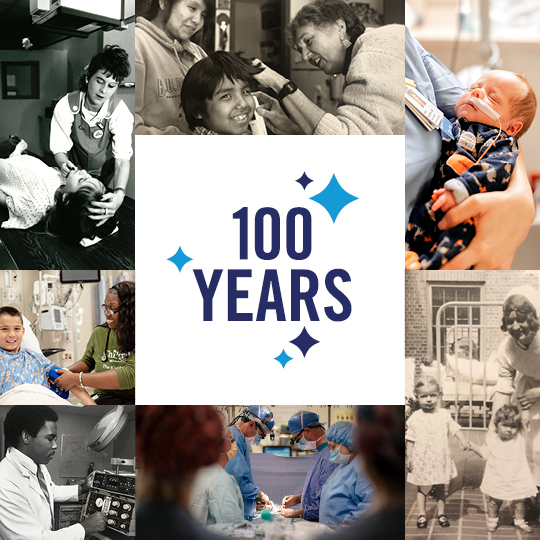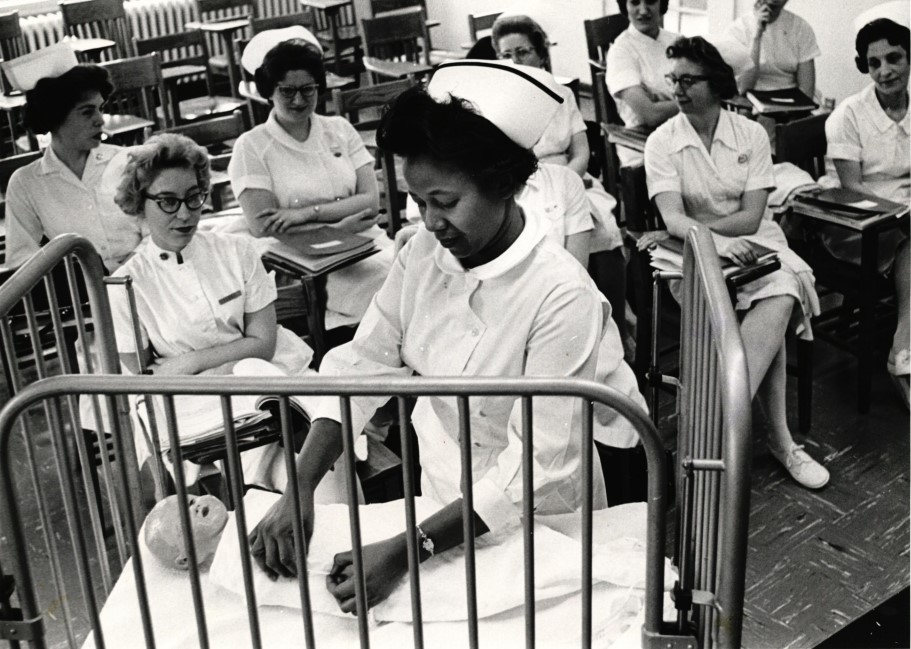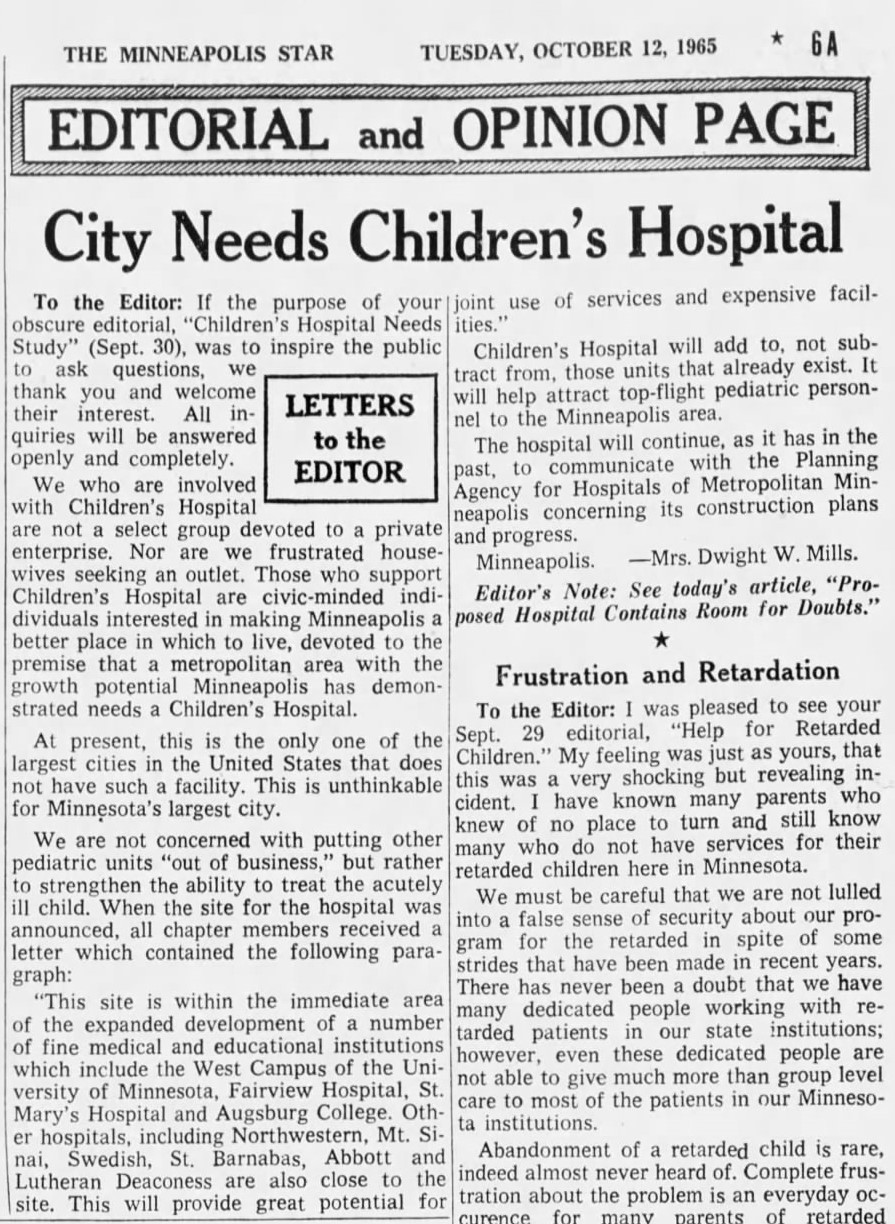for kids

From the archives: Children's Minnesota in the 1960s
The history of Children’s Minnesota is much more than buildings, names and dates. Who were the people behind the facts? What were their struggles and triumphs?
In honor of our 100th anniversary, every month in 2024 we’ll share stories from the Children’s Minnesota archives. Each month will feature a different decade.
Here, we continue with the 1960s, which saw our Minneapolis children’s hospital finally break ground amid fundraising and public relations challenges.
Jump back in time and read about Children’s Minnesota in the 1950s, 1940s, the 1930s and the 1920s.
Hard-fought hospital
By 1960, the quest to build a children’s hospital in Minneapolis had been underway for decades. But, the struggle to raise enough funds and to convince the public of the need for a children’s hospital continued throughout the 1960s.
Hospital supporters kicked off the first public fundraising campaign in the spring of 1963. They raised almost $1 million, but it wasn’t enough to reach their goal.
There was some opposition to the idea of building a hospital just for children as expressed in this 1965 editorial in the Minneapolis Star. The article argues that:
- Existing pediatric facilities in Minneapolis were adequate.
- A children’s hospital would result in empty pediatric beds in general hospitals.
- Independent specialty hospitals were a thing of the past; it’s better to build integrated medical centers.
Proponents of the children’s hospital worked hard to convince the community otherwise.
Their arguments, often waged in the press, included:
- Children need a hospital built just for them, focusing on their unique physical and emotional needs.
- Children require special care, equipment and professionals trained in pediatrics.
- There are existing pediatric beds, but they are too spread out among several general hospitals and these programs don’t have the wherewithal to deliver top-notch care.
- Pediatric beds in general hospitals can be converted to other types of beds.
- Of the largest cities in the country, Minneapolis is the only one without its own children’s hospital.
Despite fundraising and public relations setbacks, planning for the hospital continued.
In 1967 Dr. Arnold Anderson, a prominent local pediatrician, was named the hospital’s first medical director and chief executive officer.
As for where to build the hospital, various sites were considered, including near M Health Fairview Southdale Hospital in Edina and the University of Minnesota campus. Ultimately, proponents decided to build the children’s hospital at its present site in South Minneapolis.
That’s because in the 1960s several other hospitals in the neighborhood (Northwestern Hospital, Mount Sinai and Sister Kenny Institute) were joining forces, and they extended an invitation to the children’s hospital. A history of the Minneapolis hospital explains:
“In August 1966, a unique hospital ‘health campus’ movement…was being formulated. The hospitals all in close proximity along Chicago Avenue, felt they could offer a combined and integrated program of care which would not be financially possible for one hospital alone.”
By 1969, children’s hospital proponents had raised enough funds and gained enough community support to break ground. Governor Harold Levander shoveled the first dirt at the groundbreaking ceremony in December 1969. But in 1970, funds had dried up and construction was put on hold.
A new era in St. Paul
In the 1960s at Children’s Hospital, St. Paul, staff were ushering in “a new era of specialized care” according to a hospital history written by one of its founding pediatricians, Dr. Robert Rosenthal.

Changes included:
- A new communicable disease unit.
- An expanded intern program.
- A new residency program, with the first resident began training in 1966.
- A new intensive care unit for newborns. Rosenthal called it “a unique service in midwestern states.”
- More children were referred to the hospital for difficult-to-diagnose conditions.
- Opening of Children’s Hospital Clinic.
Dr. Rosenthal notes that by the end of the 1960s none of the original pediatric staff from the 1920s were still practicing at Children’s Hospital. But he says founder Dr. Walter Ramsey “at 99 years remains in good health, is mentally keen, and watches with utmost interest the fulfillment of his dream of long ago.”
Stay tuned to our From the Archives blogs! Next month will feature Children’s Minnesota in the 1970s.
Celebrating a century of care: Children’s Minnesota turns 100
Children’s Minnesota has been here for 100 years. And it’s all because of you: the people who bring their kids here, the ones who work here, the partners who refer their young patients for specialty treatment, the donors who support us, and the community who rallies around the families in our hospitals. Join us in celebrating a century of care — and a bright, healthy future for Minnesota kids.


